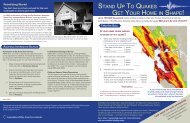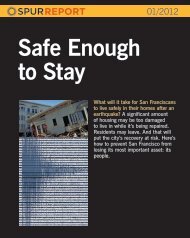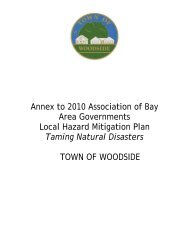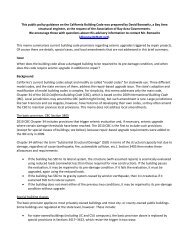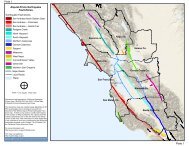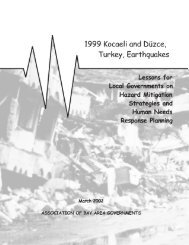Airport Liquefaction Susceptibility Analysis Report - ABAG ...
Airport Liquefaction Susceptibility Analysis Report - ABAG ...
Airport Liquefaction Susceptibility Analysis Report - ABAG ...
You also want an ePaper? Increase the reach of your titles
YUMPU automatically turns print PDFs into web optimized ePapers that Google loves.
Fugro Consultants, Inc.<br />
Project No. 04.79221200<br />
6.2 Recommendations<br />
6.2.1 <strong>Liquefaction</strong> Investigations<br />
<strong>Liquefaction</strong> investigations are necessary for Buchanan and Livermore to more fully<br />
characterize the potential aerial extent and amount of liquefaction-related deformation. Those<br />
investigations should include a review of all available subsurface data, the collection of both<br />
CPT and soil boring data and samples, geotechnical laboratory analyses that would include, at<br />
a minimum, grain size analysis and Atterberg limits, aerial photographic analysis of site<br />
development and fill placement history, and the construction of geologic cross sections across<br />
the site showing the lateral extent and thickness of fill.<br />
6.2.2 Additional Site Studies<br />
Additional site studies are necessary at Moffett and Oakland to address the gaps in subsurface<br />
data coverage across these properties. All available geotechnical and engineering geologic<br />
reports for these airports should be obtained and reviewed to identify any data suitable for<br />
liquefaction analysis and to identify areas with gaps in data coverage. Where significant<br />
coverage gaps occur, a subsurface investigation should be developed in order to collect the<br />
additional data.<br />
A more comprehensive evaluation of fill thickness and character is recommended at Moffett,<br />
Oakland, and San Francisco to address differential settlement potential and identify areas with a<br />
higher susceptibility to liquefaction. This evaluation should include a review of all available<br />
subsurface data, aerial photographic analysis of fill placement history, and the construction of<br />
geologic cross sections across the site showing the lateral extent and thickness of both fill and,<br />
specifically at Oakland, the Merritt Sand.<br />
This evaluation should also include a review of all perimeter dikes and levees at San Francisco<br />
and Oakland to assess the potential for slope stability and seepage that may result from<br />
earthquake-induced liquefaction (it should be acknowledged that OAK is currently making<br />
improvements to their dikes and levees to meet the FEMA recommendations and<br />
requirements). The borings analyzed along the perimeter levees and dikes at Oakland do not<br />
cover the first 80 feet and the last 30 feet of the alignment, resulting in the liquefaction<br />
susceptibility of fill materials in these locations poorly constrained. In addition, evidence for<br />
seepage was documented by URS (2011) along the Oakland levees and dikes between stations<br />
168+00 and 188+00 and stations 193+00 to 220+00 that should be further evaluated.<br />
6.2.3 Mitigation<br />
Various methods have been used to mitigate liquefaction hazards within the San Francisco Bay<br />
Area. Some of the most commonly used and effective techniques suggested by Martin and Lew<br />
(1999) include:<br />
27<br />
May 31, 2013



